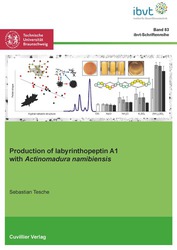| Departments | |
|---|---|
| Book Series (96) |
1378
|
| Nachhaltigkeit |
3
|
| Gesundheitswesen |
1
|
| Humanities |
2364
|
| Natural Sciences |
5406
|
| Mathematics | 229 |
| Informatics | 319 |
| Physics | 980 |
| Chemistry | 1363 |
| Geosciences | 131 |
| Human medicine | 243 |
| Stomatology | 10 |
| Veterinary medicine | 108 |
| Pharmacy | 147 |
| Biology | 835 |
| Biochemistry, molecular biology, gene technology | 121 |
| Biophysics | 25 |
| Domestic and nutritional science | 45 |
| Agricultural science | 1004 |
| Forest science | 201 |
| Horticultural science | 20 |
| Environmental research, ecology and landscape conservation | 148 |
| Engineering |
1793
|
| Common |
98
|
|
Leitlinien Unfallchirurgie
5. Auflage bestellen |
|
Advanced Search
Production of labyrinthopeptin A1 with Actinomadura namibiensis (Volume 83) (English shop)
Sebastian Tesche (Author)Preview
Extract, PDF (410 KB)
Table of Contents, PDF (89 KB)
The filamentous actinomycete Actinomadura namibiensis is the only known producer of labyrinthopeptins, a class of ribosomally synthesized and posttranslationally modified peptides (RiPPs) displaying highly attractive bioactive properties. In order to increase the labyrinthopeptin A1 productivity in shaking flask cultivations of A. namibiensis, a new cultivation method called salt-enhanced cultivation was used. Compared to the unsupplemented control, labyrinthopeptin A1 productivity was enhanced the most by addition of 50 mM (NH4)2SO4, reaching a 7-fold higher yield of 325 mg L-1 within 10 cultivation days. Salt-enhanced cultivation affected growth and product formation mechanisms, cell morphology characteristics and rheological characteristics of cultivation broth. An image analysis method was developed to quantify both the macro-morphology (pellet size and shape) and the micro-morphology (hyphal network structure) of the heterogeneous filamentous biomass in detail. Productivity-related morphological parameters were in particular the size and circularity of pellets and the degree of hyphal interweaving (hyphal network spacing). It was shown that the time-dependent change in morphology linked to the rheological properties of the cultivation broth.
The results presented in this work provide new insights into the cultivation aspects of A. namibiensis and illustrate the challenges on the way to a comprehensive understanding of the complex relationship between productivity, morphology and rheology in filamentous cultivations.
| ISBN-13 (Hard Copy) | 9783736973435 |
| ISBN-13 (eBook) | 9783736963436 |
| Final Book Format | A5 |
| Language | English |
| Page Number | 130 |
| Lamination of Cover | matt |
| Edition | 1 |
| Book Series | Schriftenreihe des Institutes für Bioverfahrenstechnik der Technischen Universität Braunschweig |
| Volume | 83 |
| Publication Place | Göttingen |
| Publication Date | 2020-12-31 |
| General Categorization | Dissertation |
| Departments |
Biology
Microbiology and biotechnology Mechanical and process engineering |
| Keywords | Actinomadura namibiensis, filamentous actinomycetes, labyrinthopeptin, lantibiotic, morphology engineering, cell morphology, image analysis, microscopy, salt-enhanced cultivation, salt supplementation, osmolality, upstream processing, medium optimization, complex medium, shaking flasks, submerged cultivation, productivity, product yield, specific growth rate, heterogeneous biomass, ammonium sulfate, mycelia, circularity, rheology, pseudoplasticity, viscoelasticity, dynamic viscosity, parallel plates, vane, space-time-yield, micro-morphology, macro-morphology, product purification, anion exchange chromatography, hydrophobic interaction chromatography, antiviral peptide, secondary metabolite, non-growth associated, filamentöse Aktinomyzeten, Labyrinthopeptin, Lantibiotikum, Morphology Engineering, Zellmorphologie, Bildanalyse, Mikroskopie, Salt-enhanced cultivation, Salz-Supplementierung, Osmolalität, Upstream Processing, Mediumoptimierung, Komplexmedium, Schüttelkolben, Submerskultur, Produktivität, Produktausbeute, spezifische Wachstumsrate, heterogene Biomasse, Ammoniumsulfat, Myzelien, Pellets, Hyphal Network Spacing, Zirkularität, Rheologie, Pseudoplastizität, Viskoelastizität, dynamische Viskosität, parallele Platten, Flügelrad, Raum-Zeit-Ausbeute, Mikro-Morphologie, Makro-Morphologie, Downstream Processing, Produkt-Aufreinigung, Anionenaustauschchromatographie, Hydrophobe Interaktionschromatographie, Adsorption, antivirales Peptid, Sekundärmetabolit, nicht wachstumsassoziiert, Wachstumsrate, Zähigkeit, Kultivierungsbedingungen, cultivation conditions, Ammoniumsalze |








